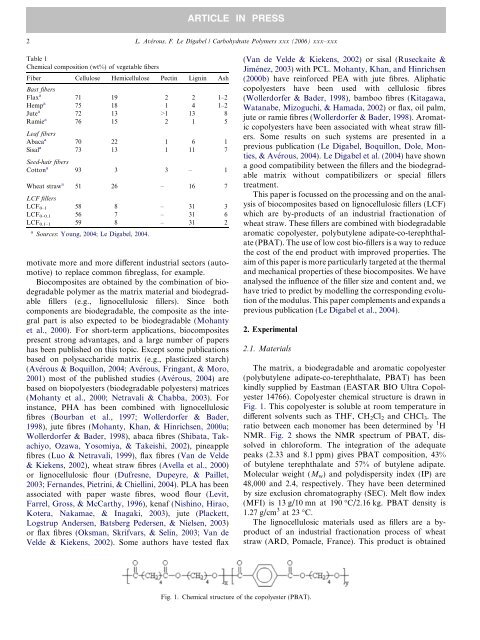Properties of biocomposites based on lignocellulosic fillers
Properties of biocomposites based on lignocellulosic fillers
Properties of biocomposites based on lignocellulosic fillers
You also want an ePaper? Increase the reach of your titles
YUMPU automatically turns print PDFs into web optimized ePapers that Google loves.
ARTICLE IN PRESS2 L. Avérous, F. Le Digabel / Carbohydrate Polymers xxx (2006) xxx–xxxTable 1Chemical compositi<strong>on</strong> (wt%) <str<strong>on</strong>g>of</str<strong>on</strong>g> vegetable fibersFiber Cellulose Hemicellulose Pectin Lignin AshBast fibersFlax a 71 19 2 2 1–2Hemp a 75 18 1 4 1–2Jute a 72 13 >1 13 8Ramie a 76 15 2 1 5Leaf fibersAbaca a 70 22 1 6 1Sisal a 73 13 1 11 7Seed-hair fibersCott<strong>on</strong> a 93 3 3 – 1Wheat straw a 51 26 – 16 7LCF <strong>fillers</strong>LCF 0–1 58 8 – 31 3LCF 0–0.1 56 7 – 31 6LCF 0.1–1 59 8 – 31 2a Sources: Young, 2004; Le Digabel, 2004.motivate more and more different industrial sectors (automotive)to replace comm<strong>on</strong> fibreglass, for example.Biocomposites are obtained by the combinati<strong>on</strong> <str<strong>on</strong>g>of</str<strong>on</strong>g> biodegradablepolymer as the matrix material and biodegradable<strong>fillers</strong> (e.g., <strong>lignocellulosic</strong> <strong>fillers</strong>). Since bothcomp<strong>on</strong>ents are biodegradable, the composite as the integralpart is also expected to be biodegradable (Mohantyet al., 2000). For short-term applicati<strong>on</strong>s, <str<strong>on</strong>g>biocomposites</str<strong>on</strong>g>present str<strong>on</strong>g advantages, and a large number <str<strong>on</strong>g>of</str<strong>on</strong>g> papershas been published <strong>on</strong> this topic. Except some publicati<strong>on</strong>s<str<strong>on</strong>g>based</str<strong>on</strong>g> <strong>on</strong> polysaccharide matrix (e.g., plasticized starch)(Avérous & Boquill<strong>on</strong>, 2004; Avérous, Fringant, & Moro,2001) most <str<strong>on</strong>g>of</str<strong>on</strong>g> the published studies (Avérous, 2004) are<str<strong>on</strong>g>based</str<strong>on</strong>g> <strong>on</strong> biopolyesters (biodegradable polyesters) matrices(Mohanty et al., 2000; Netravali & Chabba, 2003). Forinstance, PHA has been combined with <strong>lignocellulosic</strong>fibres (Bourban et al., 1997; Wollerdorfer & Bader,1998), jute fibres (Mohanty, Khan, & Hinrichsen, 2000a;Wollerdorfer & Bader, 1998), abaca fibres (Shibata, Takachiyo,Ozawa, Yosomiya, & Takeishi, 2002), pineapplefibres (Luo & Netravali, 1999), flax fibres (Van de Velde& Kiekens, 2002), wheat straw fibres (Avella et al., 2000)or <strong>lignocellulosic</strong> flour (Dufresne, Dupeyre, & Paillet,2003; Fernandes, Pietrini, & Chiellini, 2004). PLA has beenassociated with paper waste fibres, wood flour (Levit,Farrel, Gross, & McCarthy, 1996), kenaf (Nishino, Hirao,Kotera, Nakamae, & Inagaki, 2003), jute (Plackett,Logstrup Andersen, Batsberg Pedersen, & Nielsen, 2003)or flax fibres (Oksman, Skrifvars, & Selin, 2003; Van deVelde & Kiekens, 2002). Some authors have tested flax(Van de Velde & Kiekens, 2002) or sisal (Ruseckaite &Jiménez, 2003) with PCL. Mohanty, Khan, and Hinrichsen(2000b) have reinforced PEA with jute fibres. Aliphaticcopolyesters have been used with cellulosic fibres(Wollerdorfer & Bader, 1998), bamboo fibres (Kitagawa,Watanabe, Mizoguchi, & Hamada, 2002) or flax, oil palm,jute or ramie fibres (Wollerdorfer & Bader, 1998). Aromaticcopolyesters have been associated with wheat straw <strong>fillers</strong>.Some results <strong>on</strong> such systems are presented in aprevious publicati<strong>on</strong> (Le Digabel, Boquill<strong>on</strong>, Dole, M<strong>on</strong>ties,& Avérous, 2004). Le Digabel et al. (2004) have showna good compatibility between the <strong>fillers</strong> and the biodegradablematrix without compatibilizers or special <strong>fillers</strong>treatment.This paper is focussed <strong>on</strong> the processing and <strong>on</strong> the analysis<str<strong>on</strong>g>of</str<strong>on</strong>g> <str<strong>on</strong>g>biocomposites</str<strong>on</strong>g> <str<strong>on</strong>g>based</str<strong>on</strong>g> <strong>on</strong> <strong>lignocellulosic</strong> <strong>fillers</strong> (LCF)which are by-products <str<strong>on</strong>g>of</str<strong>on</strong>g> an industrial fracti<strong>on</strong>ati<strong>on</strong> <str<strong>on</strong>g>of</str<strong>on</strong>g>wheat straw. These <strong>fillers</strong> are combined with biodegradablearomatic copolyester, polybutylene adipate-co-terephthalate(PBAT). The use <str<strong>on</strong>g>of</str<strong>on</strong>g> low cost bio-<strong>fillers</strong> is a way to reducethe cost <str<strong>on</strong>g>of</str<strong>on</strong>g> the end product with improved properties. Theaim <str<strong>on</strong>g>of</str<strong>on</strong>g> this paper is more particularly targeted at the thermaland mechanical properties <str<strong>on</strong>g>of</str<strong>on</strong>g> these <str<strong>on</strong>g>biocomposites</str<strong>on</strong>g>. We haveanalysed the influence <str<strong>on</strong>g>of</str<strong>on</strong>g> the filler size and c<strong>on</strong>tent and, wehave tried to predict by modelling the corresp<strong>on</strong>ding evoluti<strong>on</strong><str<strong>on</strong>g>of</str<strong>on</strong>g> the modulus. This paper complements and expands aprevious publicati<strong>on</strong> (Le Digabel et al., 2004).2. Experimental2.1. MaterialsThe matrix, a biodegradable and aromatic copolyester(polybutylene adipate-co-terephthalate, PBAT) has beenkindly supplied by Eastman (EASTAR BIO Ultra Copolyester14766). Copolyester chemical structure is drawn inFig. 1. This copolyester is soluble at room temperature indifferent solvents such as THF, CH 2 Cl 2 and CHCl 3 . Theratio between each m<strong>on</strong>omer has been determined by 1 HNMR. Fig. 2 shows the NMR spectrum <str<strong>on</strong>g>of</str<strong>on</strong>g> PBAT, dissolvedin chlor<str<strong>on</strong>g>of</str<strong>on</strong>g>orm. The integrati<strong>on</strong> <str<strong>on</strong>g>of</str<strong>on</strong>g> the adequatepeaks (2.33 and 8.1 ppm) gives PBAT compositi<strong>on</strong>, 43%<str<strong>on</strong>g>of</str<strong>on</strong>g> butylene terephthalate and 57% <str<strong>on</strong>g>of</str<strong>on</strong>g> butylene adipate.Molecular weight (M w ) and polydispersity index (IP) are48,000 and 2.4, respectively. They have been determinedby size exclusi<strong>on</strong> chromatography (SEC). Melt flow index(MFI) is 13 g/10 mn at 190 °C/2.16 kg. PBAT density is1.27 g/cm 3 at 23 °C.The <strong>lignocellulosic</strong> materials used as <strong>fillers</strong> are a byproduct<str<strong>on</strong>g>of</str<strong>on</strong>g> an industrial fracti<strong>on</strong>ati<strong>on</strong> process <str<strong>on</strong>g>of</str<strong>on</strong>g> wheatstraw (ARD, Pomacle, France). This product is obtainedFig. 1. Chemical structure <str<strong>on</strong>g>of</str<strong>on</strong>g> the copolyester (PBAT).



